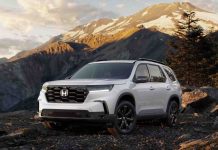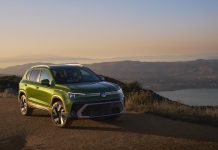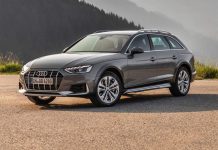Yes, it’s pretty small.
But the new Honda Fit hatchback sedan — which starts at $13,850 for the base model with 5-speed manual transmission — is more than just another depressing poor-boy econo-box. Its box is actually pretty big, in fact. Though nearly two feet shorter overall than the current Civic sedan, the Fit’s interior has almost as much space as the current (and mid-sized) Accord. Four adults can ride comfortably; five in a pinch. Seriously. (Don’t even try that in a Geo Metro. The results will not be pretty.)
New to North America, the Fit is a so-called “B-car” — auto industry jargon for a category of car (hatchback, sedan or wagon) that’s one step in overall size below the typical subcompact, but still larger than the micro-sized “A-cars” sold in European and other export markets. Honda is betting that market conditions in the United States and Canada (read: escalating gas prices) will make the new Fit just as popular on this side of the pond.
Seems like a pretty safe bet!
If you look at the car, you’ll begin to see the genius of it. The Fit’s wheels are pushed out to the four corners, with very little “overhang” (the portion of the bodywork that extends beyond the front wheels in the front and the rear wheels in the back of the car). This shortens the overall length — without scrunching up the passenger compartment. Ditto the front and rear door panels — which are noticeably longer/larger than the front and rear fenders. Honda also relocated the fuel tank (it’s snugged up against the passenger compartment floorpan instead of behind the rear seats, as is common practice) to provide another few square feet of interior volume that woud otherwise be so much wasted space. And while the car is low to the ground, the tall roofline means there’s plenty of headroom — even for back seat occupants as tall as 6 ft. 3 (like me). And you don’t have to crouch down to get in, either.
But what makes the Fit more-than-usually functional, inside-wise, is the unique multi-configurable “magic seat” layout. You can go from a three-across bench-style back seat (and five-passenger capacity) to nearly four feet of space from floor to ceiling — because unlike conventional fold-flat second-row seats, the Fit’s rear seats fold up (as well as down) making room inside for an object as large as a standard-sized bicycle. Or fold the front passenger seat down — it can be fully reclined — and enjoy a catnap if you like. And if you drop the front passenger seat and lower the second row bench, you can carry home objects almost eight feet long. Overall, there’s 41.9 cubic feet of cargo space available with the second row folded flat. Even with the back seats up and in place, there is room in the small cargo area (accessible by raising the hatchback door) for a large dog or several bags of groceries.
It’s as clever and functional and right-for-the-times in its own way as the original Civic CVCC was a quarter-century ago. And likely to be just as successful.
All Fits come standard with AC, power windows and locks, a stereo with CD player and ABS. Side impact head/curtain air bags are also included — a lot of stuff for a car with a sticker price under $14k. Watch out, Hyundai and Kia; Honda’s not about to cede the low price/high value market just yet. And Toyota’s subcompact Yaris doesn’t even come close — no multi-configurable seats, no standard ABS or side/curtain air bags. (You don’t even get a radio in the standard Yaris sedan; just “pre-wiring.”)
The Fit’s compact exterior dimensions and electric-assist power steering make it exceptionally easy to maneuver and park in close-in/crowded city/suburban traffic — while its light weight (barely 2,500-lbs.) translates into respectable performance (0-60 in 9.3-9.5 seconds with the 5-speed manual transmission), even though the 1.5 liter engine makes just 109 horsepower. Sure, the 140-mph speedo’s a bit optimistic — but the Fit doesn’t struggle pathetically to reach 70-75 mph and still has a decent margin left in reserve. This makes it perfectly serviceable for long trips — previously an iffy/unpleasant experience in a car of this type. And you’ll tickle 40 mpg on the highway — not far off the “real world” pace of much more costly hybrid gas-electrics like the Toyota Prius. But for about 35-40 percent less on the front end. (Use the cash you save to keep you in “free gas” for the next 3-5 years; or buy that widescreen hi-definition screen you’ve bee
n wanting.)
The as-it-sits Fit already has pretty much everything you really need — but if you want to spend more money, you can. There’s a step-up Sport model with a slightly higher price ($15,970) which gets you larger 15-inch alloy wheels (14s are standard) with fatter tires, some exterior body cladding, a leather-wrapped steering wheel, cruise control, keyless entry and an upgrade stereo with MP3 capability. Some of these things are nice to have — but none (except, possibly, cruise control) are things you’d feel poor without.
Either way, the Fit is fun, versatile, affordable — and economical. But you think about the first three things first — with the Fit’s efficiency being like the icing on the cake. An extra bennie. It’s probably the first car of its type that’s appealing in its own right — even if gas still cost $1.50 per gallon.
But with the price of fuel headed everupward it’s also a pretty smart buy.
Throw it in the Woods?










Great review, Eric. Thanks. I’m comparing the 2013 Fit with the Nissan Versa Note. Any thoughts?
Thanks, Stu!
On the Versa: I was disappointed when Nissan “sedanized” the base (lowest price) version. It’s not a bad car – but the taller-roofed/roomier hatchback was (and is) preferable, at least in my opinion. You literally got more car for your money.
And that was a problem. I suspect Nissan was losing too much money on the $11k hatchback – and that accounts for the decision to increase the price you have to pay to get the hatchback sedan vs. the base (and traditionally laid-out) Versa sedan.
Of course, the above applies to the new stuff and you’re shopping used models.
The Fit is about to be redesigned (2015) and this may affect prices (either way) of the old model, depending on how well-received the ’15 is.
Probably, you’ll be able to get a better deal, money-wise, on the Nissan just because Hondas (and Toyotas) tend to be pricier on the used market due to the Halo Effect of their reputation. But Nissans are excellent vehicles (disclosure, I own two) so don’t let that worry you. In fact, take advantage of it!
IIRC, the Versa (hatchback version) has a roomier back seat. Both cars have airy-spacious feeling cabins and are enjoyable to drive, but the Honda’s steering/handling are a bit sharper. On the other hand, the ride is firmer-feeling, too.
These things are highly subjective, of course – which is why I always recommend going by how the car feels to you as opposed to how it felt to me. Test drive each one for at least half an hour, if possible. This will give you the feedback you need to make the right decision.
Keep us posted!